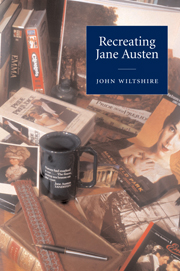Book contents
- Frontmatter
- Contents
- Preface and acknowledgments
- A note on texts
- Introduction: ‘Jane Austen’ and Jane Austen
- 1 Imagining Jane Austen's life
- 2 Recreating Jane Austen: Jane Austen in Manhattan, Metropolitan, Clueless
- 3 An Englishwoman's constitution: Jane Austen and Shakespeare
- 4 From drama, to novel, to film: inwardness in Mansfield Park and Persuasion
- 5 Pride and Prejudice, love and recognition
- 6 The genius and the facilitating environment
- Notes
- A note on films cited
- Bibliography
- Index
2 - Recreating Jane Austen: Jane Austen in Manhattan, Metropolitan, Clueless
Published online by Cambridge University Press: 22 September 2009
- Frontmatter
- Contents
- Preface and acknowledgments
- A note on texts
- Introduction: ‘Jane Austen’ and Jane Austen
- 1 Imagining Jane Austen's life
- 2 Recreating Jane Austen: Jane Austen in Manhattan, Metropolitan, Clueless
- 3 An Englishwoman's constitution: Jane Austen and Shakespeare
- 4 From drama, to novel, to film: inwardness in Mansfield Park and Persuasion
- 5 Pride and Prejudice, love and recognition
- 6 The genius and the facilitating environment
- Notes
- A note on films cited
- Bibliography
- Index
Summary
To articulate the past historically does not mean to recognise it ‘the way it really was’. It means to seize hold of a memory as it flashes up at a moment of danger … In every era the attempt must be made anew to wrest tradition away from a conformism that is about to overpower it.
Walter Benjamin, ‘Theses on the Philosophy of History’‘Re-vision’ – ‘the act of looking back, of seeing with fresh eyes, of entering an old text from a new critical direction’ – has been the name of the game in literary and cultural criticism for the last three decades. Meanwhile ‘revision’, in the sense of borrowing from an original to further one's own artistic purposes, has been pursued even more vigorously within the novel, the theatre and film. Inevitably, perhaps, it has been Shakespeare who has served as the cultural hero against whom most artists have wanted to measure themselves, playfully or angrily rewriting the plays from radical, postcolonial, feminist, lesbian or gay points of view, or borrowing from his plots to give added resonance to their own enterprises. There is an immense range and variety of such ‘appropriations’. From the disconcerting eruption into Gus Van Sant's tale of Seattle rentboys, My Own Private Idaho (1991) of lines and even whole scenes of Henry IV, to the incestuous Lear of Jane Smiley's A Thousand Acres (1991) Shakespeare has been ‘plundered’ to serve purposes as diverse as diligent modernisation and outright burlesque.
- Type
- Chapter
- Information
- Recreating Jane Austen , pp. 38 - 57Publisher: Cambridge University PressPrint publication year: 2001

